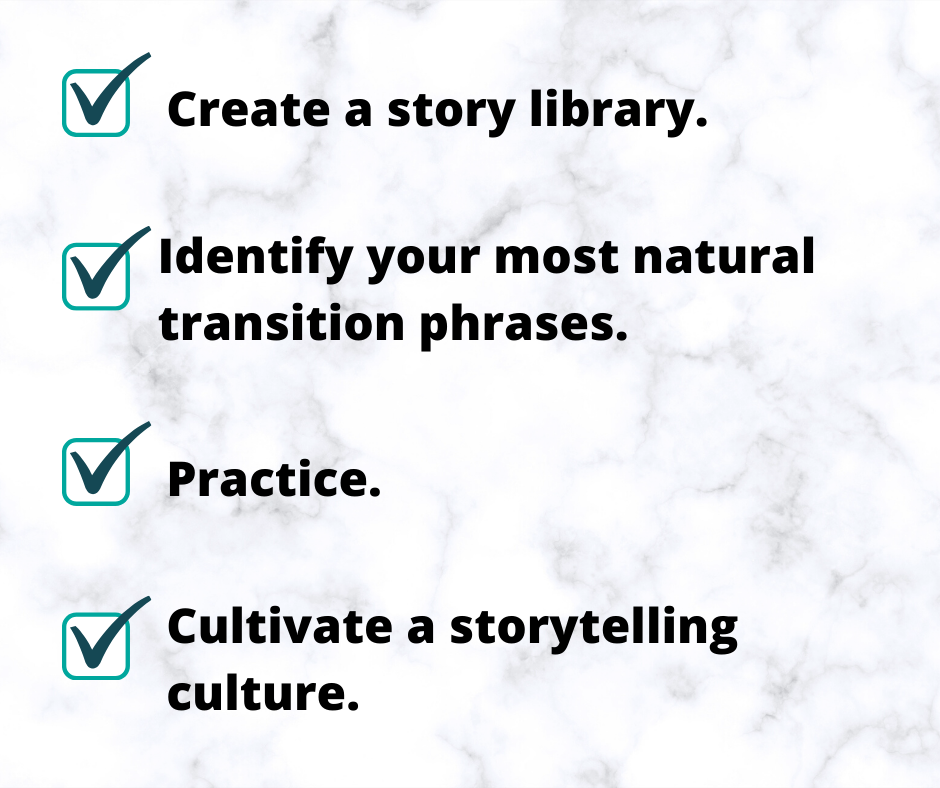May 26, 2020 / Esther Choy

You know leadership storytelling is powerful. You’ve figured out how to choose the right stories to tell. Just one small problem. For many leaders, sharing stories in everyday conversation feels awkward. As a participant in one recent Leadership Story Lab workshop put it, “How do we incorporate stories professionally so it doesn’t seem so ‘off’ and ‘weird’?”
Here’s a four-step checklist for making storytelling come naturally in every conversation.
Step 1: Create a story library.
The best way to incorporate a natural-sounding story is to have a lot of stories to choose from. That way, you’re not forcing a story to fit the occasion, you have a story at your fingertips that actually applies!
Get organized. Start a storytelling spreadsheet.
-
In column A, create a list of experiences you think a lot of people probably share. For instance, being a middle child, having a non-traditional path through school, being in the military, or taking a gap year that turned into five years. Brainstorm as many shared experiences as you can.
-
In column B, develop examples of these shared experiences from your own life.
-
In column C, consider what these examples tell other people about your character.
-
In column D, dig into the meaning behind your examples.

Now you are ready to share more stories in your conversations.
Step 2: Identify your most natural transitional phrases.
It can be easy to tell stories when conversation is already flowing easily, the way it does between friends. It’s much harder when you’re at a networking event, meeting someone for the first time.
-
“Oh, that reminds me of….”
-
“I remember when….”
-
“That’s just like this one time…”
Taking the risk and sharing a story that was personal (but not private) paid off. Not only did it forge a stronger connection, it also led her mentor to seek Tina’s advice about storytelling when she had to give an important presentation. This also took their relationship to a new level. Because Tina took the risk of telling a story, they became collaborators.
Step 3: Practice.
In business environments, people often feel that stories are a luxury. But far from being an extravagance, stories help listeners process information better and make information up to 20 times more memorable. Even when we know that, it can be difficult to interrupt a fast-paced, efficient meeting to interject a story. (This is especially the case during video meetings, where it can be especially difficult to get others’ attention and time always seems crunched.)
Don’t share your first draft. Don’t share an unprepared story. Practice it and share it with others before you attempt to share it in a meeting where you hope to be efficient.
However, I was thrilled that this participant told such a story! A workshop was exactly the right place for this kind of experimentation. Together, we shaped it and made it better, so that when he tells the story again it will be more concise and efficient.
Step 4: Cultivate a storytelling culture.

Opportunities for sharing stories in the workplace are abundant. But because we’re not used to doing it, initially it might feel awkward, just like those few first times starting to exercise at the gym. But once you get used to it, it’ll actually feel strange when you’re not inserting stories all the time.
Related Articles
Tired of Small Talk? Collect Stories
What Is Leadership Storytelling, Anyway?
We’d love to help you become a pro at sharing stories in your conversations more naturally. We’ll help you choose and shape the right stories for the right opportunity. Start the conversation!
For more examples of the right stories to tell at the right time, sign up for our monthly guide. My book, Let the Story Do the Work (published by HarperCollins Leadership), is now available and serves as your business storytelling toolkit.
This article originally appeared on Forbes.com.
1 Comments
Leave a Comment
Better Every Story
Leadership Transformation through Storytelling
"This is an amazing and insightful post! I hadn’t thought of that so you broadened my perspective. I always appreciate your insight!" - Dan B.
Get Esther Choy’s insights, best practices and examples of great storytelling to your inbox each month.



Esther, I’ve done something similar with interviews. And this has helped me a lot. Sometimes just being able to references those initial transition phrases is all your need to get going in your story.